Author: Alvis, Mars Finance
We have witnessed the sweeping of DeFi Summer, the NFT craze, and the frenzy of the metaverse. So, will the next big trend turn to DePIN?
Between 2020 and 2021, the market value of DeFi soared nearly 100 times, from $1.75 billion to $172.2 billion. If the market value of DeFi grows tenfold in the current bull market and DePIN reaches 50% of the market value of DeFi, then the total market value of DePIN is expected to exceed $500 billion, still with at least 20 times growth potential. Messari estimates that by 2028, the market value of DePIN will reach $35 trillion, indicating a potential 120-fold growth for DePIN.
Next, we will take stock of eight popular DePIN projects that have been launched, have not yet been issued, or have just been financed since 2024, revealing the future trends of this emerging field.
Current Status of Depin
DePIN represents a decentralized physical infrastructure network that encourages users to share personal resources through token incentives to build infrastructure networks, including storage space, communication traffic, cloud computing, energy, and other areas. In simple terms, DePIN, in a crowdsourcing form, distributes the infrastructure originally provided by centralized companies to users worldwide.
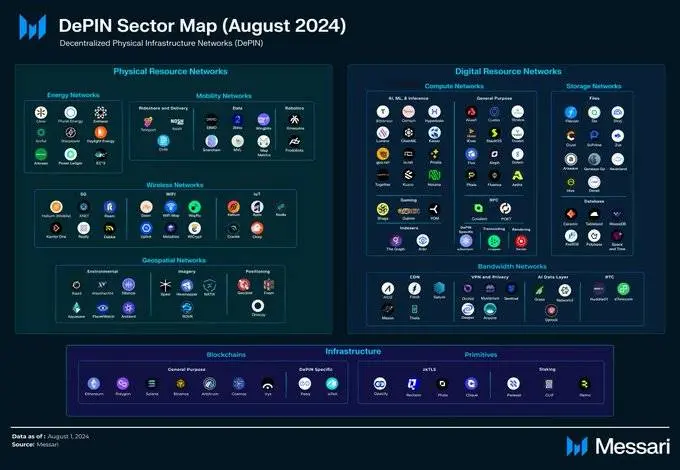
Source: Messari
The DePIN ecosystem can be divided into six major categories: computing, wireless, energy, artificial intelligence, services, and sensors. In these core areas, several new narratives have emerged recently, such as the rise of decentralized gaming infrastructure (DeGIN) in the computing network, the application of AI data layers in the bandwidth network, breakthroughs in robot technology in the mobile network, and the demand for mobile networks in the manufacturing industry.
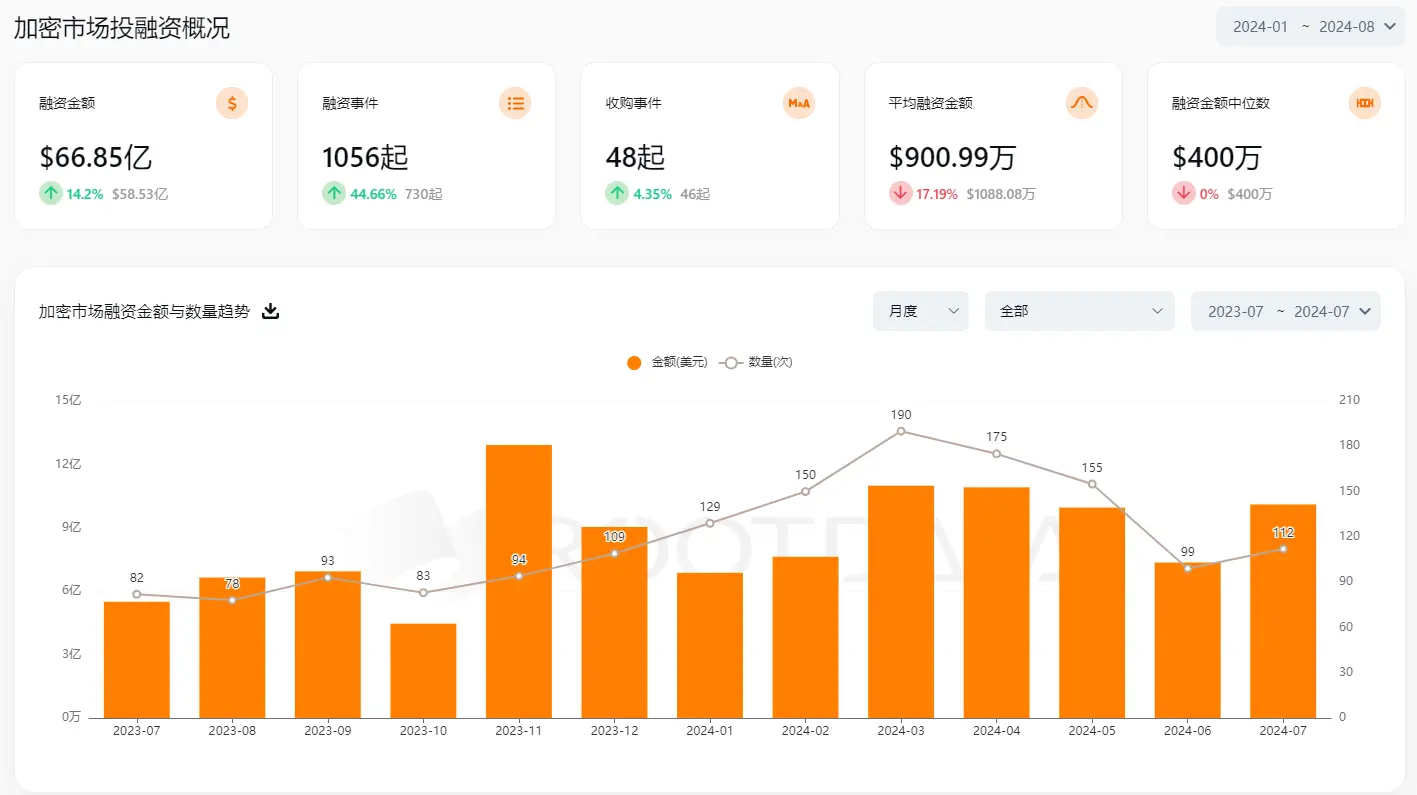
Image Source: Rootdata
This year, venture capital funding for crypto projects has seen a significant recovery. According to Rootdata, as of August 2024, the total global investment amount has reached $6.7 billion. In recent months, the rise of the DePIN network has shown a market fit similar to the early stages of the "sharing economy," covering multiple areas of DePIN, each demonstrating unique application scenarios.
Notable investment highlights include io.net, a Solana-based distributed GPU project, which successfully raised $20 million in its Series A financing, with a token valuation of $1 billion; another noteworthy project is Aethir, a decentralized GPU computing node provider, which raised $65 million in the first hour of its node sale. These achievements mark the rapid maturation of the DePIN field, attracting substantial investments and widespread attention.
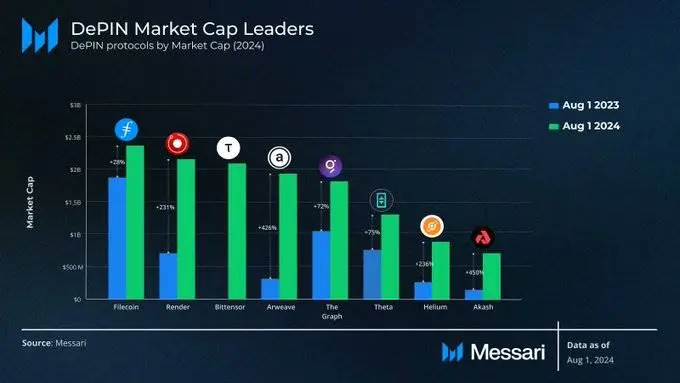
DePIN Market Value Overview, Source: Messari
According to Messari's data, the total market value of DePIN projects has exceeded $20 billion. Among them, Filecoin leads the DePIN projects with a market value of up to $2.4 billion, ranking first. Following closely is Render Network, with a market value of $2.2 billion, ranking second. Opentensor closely follows, with a market value of $2.1 billion, ranking third. Among the top eight DePIN protocols ranked by market value, seven belong to DRN (decentralized resource networks), with a total market value of $12.2 billion. Helium is the only physical resource network (PRN) to enter the top eight, with a market value of $870 million, ranking seventh. These data demonstrate the rapid development and diversified investment opportunities in the DePIN field.
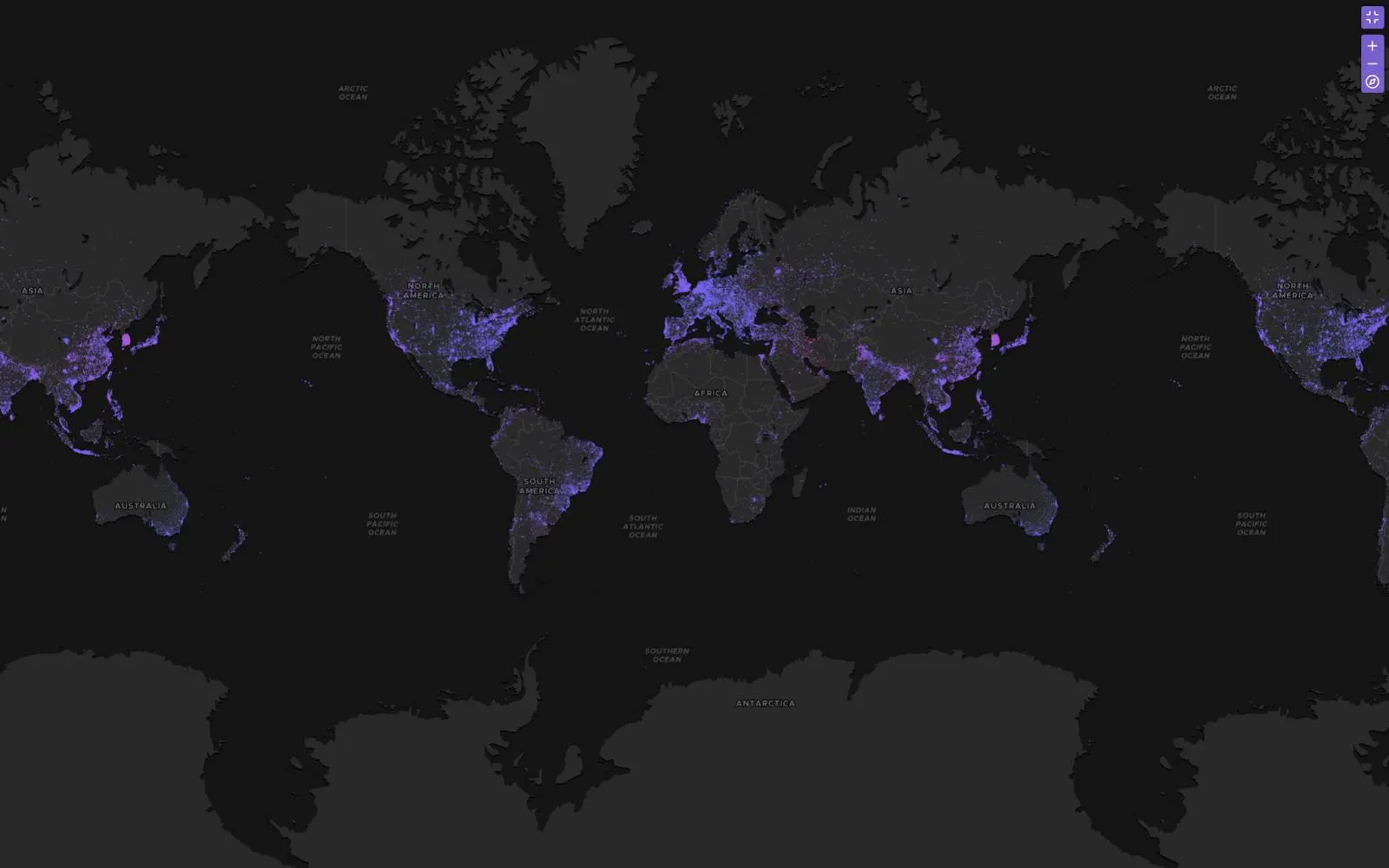
Global Distribution of DePIN Nodes, Image Source: DePINScan
Currently, the total number of Depin devices is as high as 18 million, with nodes spread across 195 countries and regions, mainly concentrated in North America, East Asia, Southeast Asia, Europe, and Africa.
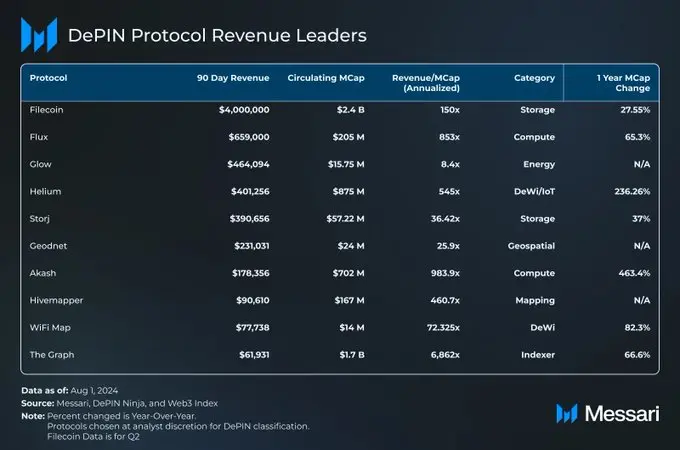
DePIN Revenue Overview, Source: Messari
Although the market value of DePIN projects continues to rise, its revenue growth has not kept pace. Currently, only four of the largest DePIN protocols hold a place in the top eight ranked by revenue. While the valuations of these projects remain very high, with a future fully diluted valuation (FDV) to revenue ratio of up to 3000 times, the inflow of funds remains strong, and investors are full of expectations for stronger product-market fit. The entire ecosystem has expanded to include over 2500 projects and has over 600,000 active nodes. These data reflect the contradiction between market recognition and actual income in the DePIN field, as well as the potential and challenges for future growth.
Today, Mars Finance will take stock of eight popular projects launched since 2024, revealing how these cutting-edge technologies play a key role in the DePIN ecosystem. Through this inventory, you will have the opportunity to explore potential wealth opportunities and seize investment opportunities.
Eight Popular Projects
IoTeX
IoTeX is a Layer 1 blockchain compatible with the Ethereum Virtual Machine (EVM), dedicated to providing a secure and reliable environment for human-machine interaction, aiming to support the Internet of Trusted Things. By building a trusted IoT platform, IoTeX not only powers various decentralized applications (such as Cyclone and Mimo), smart devices (such as UCam and Pebble), services (such as ioay and ioTube), and decentralized networks for digital assets, but also brings higher value and richer experiences to end users.
Since completing a total of $35 million in financing between 2018 and 2022, IoTeX received another $50 million in funding in April 2024. This round of financing was participated in by top investment institutions such as Borderless Capital, Amber Group, Foresight Ventures, FutureMoney Group, SNZ, Metrics Ventures, EV3, and Waterdrip Capital. The IoTeX team stated that this investment will be mainly used to drive the development of DePIN and the adoption of the ecosystem through long-term staking of IOTX (IoTeX's core token). In addition, the funds will be further invested in DePIN projects based on IoTeX, in collaboration with the IoTeX Foundation and the DePINsurf accelerator fund, to promote the landing of more innovations and applications.
Currently, IoTeX has released the new IoTeX 2.0 whitepaper. The new whitepaper details the platform's modular composition, unified trust layer, and brand-new token economics. The goal of this plan is to onboard 100 million devices in the next 3 to 5 years and unlock trillions of dollars in value. This strategy not only signifies IoTeX's ambition in driving technological frontiers and market expansion but also demonstrates its commitment to achieving broad influence and long-term development.

The core token IOTX of IoTeX is currently priced at $0.03. In the past 7 days, the price has dropped by -9.10%, and it has decreased by -3.60% in the global cryptocurrency market. Previously, the OKX Web3 wallet had integrated IoTeX. It is worth paying attention to whether IOTX will be listed on OKX and its token trend!
io.net
io.net is a revolutionary decentralized computing network focused on developing, executing, and scaling machine learning (ML) applications on the Solana blockchain. By combining 1 million GPUs, it has created the world's largest GPU cluster, providing unprecedented processing power for compute-intensive tasks. What sets io.net apart is its aggregation of underutilized GPU resources, including independent data centers, crypto miners, and resources from crypto projects like Filecoin and Render. This integration forms a powerful computing platform in the decentralized physical infrastructure network (DePIN), enabling engineers to access massive computing power in an accessible, customizable, cost-effective, and easy-to-implement environment.
In terms of financing, io.net successfully completed a $10 million seed round last year and rapidly secured a $30 million Series A financing this year. Its investment team lineup provides strong financial support for the project's future development. Currently, io.net's architecture has taken shape, including core components such as IO Network and IO Engine, aiming to efficiently share GPU resources in a decentralized manner, significantly improving resource utilization.
io.net executes a fixed preset program for the repurchase and destruction of $IO tokens, and the specific repurchase and destruction quantity depends on the price of $IO at the time of execution. The funds used to repurchase $IO come from the operational income of IOG (The Internet of GPUs - GPU Internet), collecting a 0.25% order booking fee from both the compute power buyers and providers in IOG, as well as a 2% fee for compute power purchases using $USDC. Increasing the token's scarcity through repurchase and destruction further enhances its value. However, as a nascent project, io.net still faces some challenges in technical implementation and market demand matching. Investors and observers need to closely monitor its development.
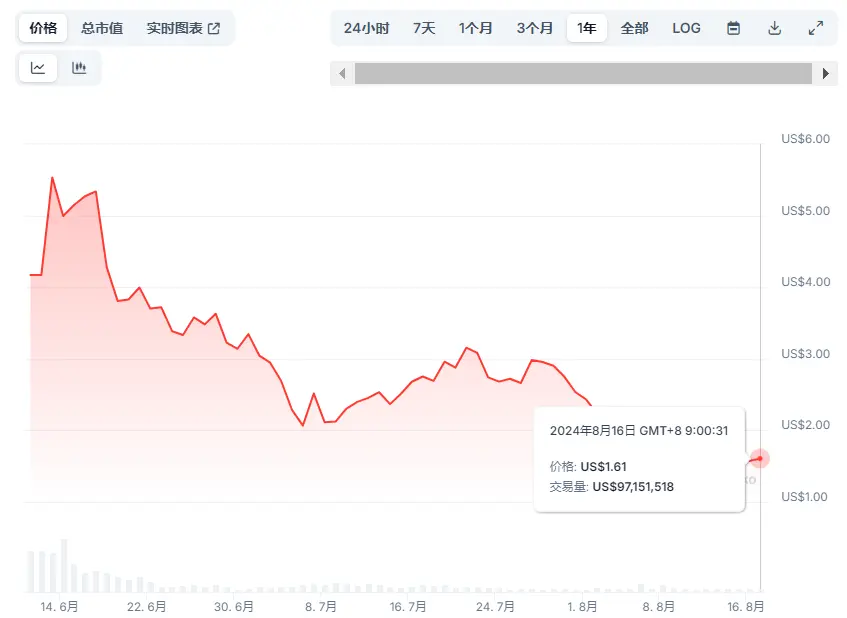
Not long ago, the second largest exchange in South Korea, Bithumb, listed IO, which has already been listed on multiple mainstream exchanges such as Binance. IO currently has a market value of $150 million, FDV of $1.28 billion, a maximum supply of 8 billion, and a current circulation rate of 11.88%.
Aethir
Aethir is a decentralized real-time rendering network aimed at elevating the accessibility of metaverse content to new heights. By building a scalable decentralized cloud infrastructure (DCI), it enables game and AI companies to deliver their products directly to global users, breaking geographical and hardware limitations.
To date, Aethir's GPU network and cloud services have generated over $36 million in annual revenue, which is converted into ATH tokens every week, ensuring users can easily access computing power. This revenue level not only surpasses most DePIN projects but also demonstrates Aethir's strong position in the market. In the AI field, Aethir's collaboration with TensorOpera is particularly noteworthy. Leveraging Aethir's decentralized GPU infrastructure, TensorOpera successfully trained an AI model with 750 million parameters, showcasing its strong capabilities in high-performance computing.
As of now, through the initial DEX offering (IDO) and other financing rounds, Aethir has successfully raised a total of $11.53 million. The public sale raised $2.53 million, with the Pre-A round of financing totaling $9 million, accounting for 78% of the total financing amount. This financing values Aethir at $150 million.
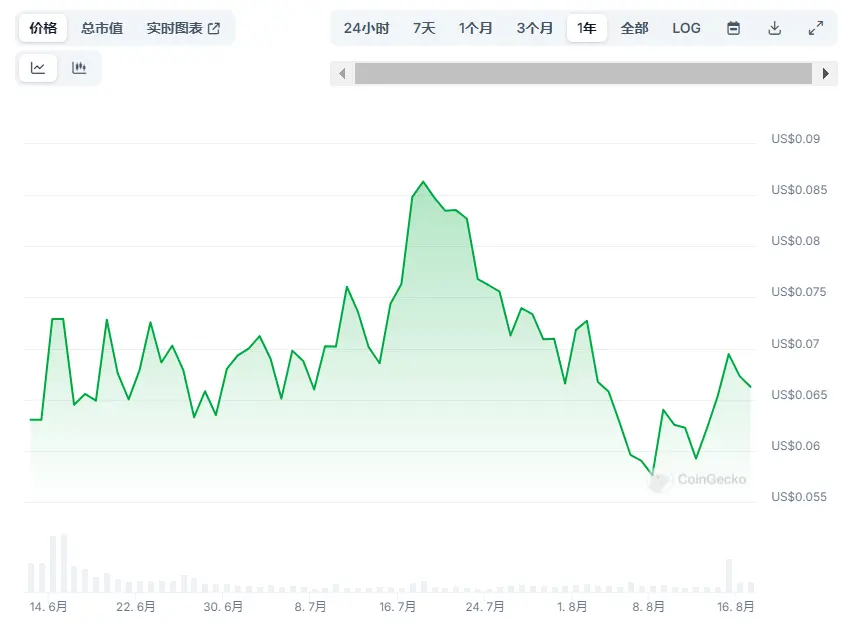
ATH currently has a market value of $260 million, FDV of $2.7 billion, and a current circulation rate of 9.66%. Its main trading markets are on OKX, Bybit, HTX, gate.io, KuCoin, and it was recently listed on the two largest exchanges in South Korea.
Bittensor
Bittensor is an open-source protocol dedicated to supporting blockchain-based machine learning networks. The protocol rewards participants with TAO tokens for facilitating collaborative training of machine learning models and contributing information value to the collective. Additionally, TAO tokens grant users the permission to extract information from the network and allow them to adjust their activities according to their needs. Bittensor's ultimate vision is to create a decentralized marketplace for artificial intelligence, where consumers and producers can interact in an environment that is trustless, fully transparent, and driven by incentives.
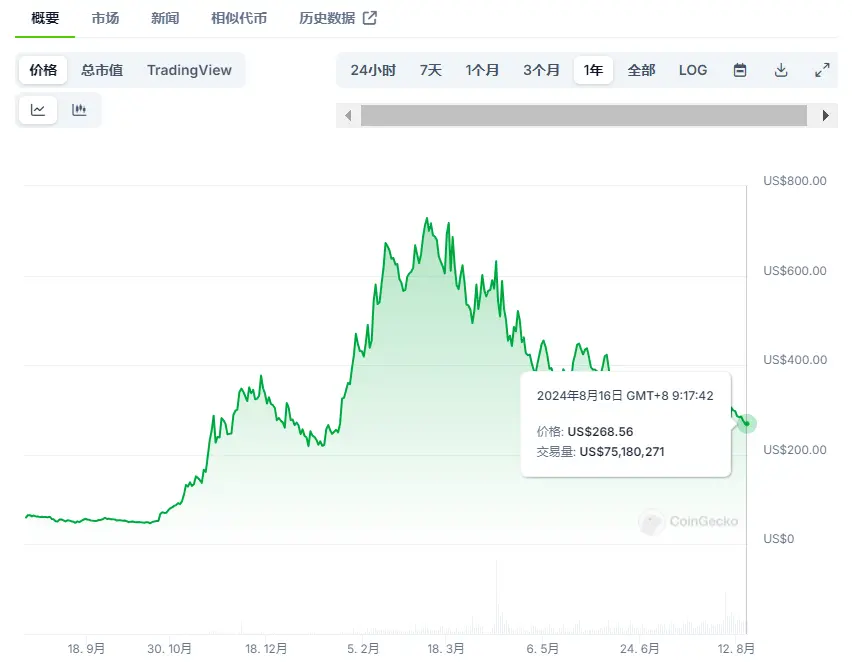
Since the end of last year, with the fervor in the field of artificial intelligence, Bittensor has stood out. Its token TAO's price rapidly soared from around $80 in October last year to over $730 in March this year, and its market value briefly climbed to about $4.7 billion. With its innovative narrative, Bittensor quickly rose to become a leader in the AI race and briefly entered the top 30 in cryptocurrency market value. Currently, the TAO token price has fallen to $268.
However, Bittensor's story is far from over. The ecosystem is just getting started. In 2024, as the first AI project to launch a public sale on CoinList, Masa announced the launch of an LLM-based AI data subnet on Bittensor, becoming the first tokenized data subnet in the Bittensor ecosystem after TAO. Masa's launch marks the only new star in the pan-Bittensor ecosystem after TAO, an eye-catching "new coin."
DIMO Network
DIMO is a decentralized IoT platform for software and hardware, allowing users to create verified vehicle data streams to privately share with applications, enabling users to negotiate better services, such as car financing and insurance. Digital Infrastructure is building the DIMO network, a decentralized car data protocol, and DIMO Mobile, an application that allows drivers to collect and view their own car data and collect rewards in DIMO tokens.
Alex Felix, Managing Partner and Chief Investment Officer of CoinFund, will join the board of Digital Infrastructure. The new round of financing brings Digital Infrastructure's total financing to $22 million.
$DIMO is an ERC-20 token on the Polygon and Ethereum blockchains, with a token supply of 1,000,000,000.
7 billion $DIMO will be initially allocated to the community-controlled DAO treasury. Teams and individuals contributing to the network may receive $DIMO in the form of bounties or grants (and/or other cryptocurrencies accumulated in the treasury). However, the primary way for most users to earn tokens is through driver rewards.
The remaining 300,000,000 $DIMO has been allocated to the initial team (approximately 224,000,000) and investment partners (approximately 76,000,000). These allocations have a minimum lock-up period of two years from the launch of the mainnet, with tokens unlocking monthly until fully unlocked after three years.
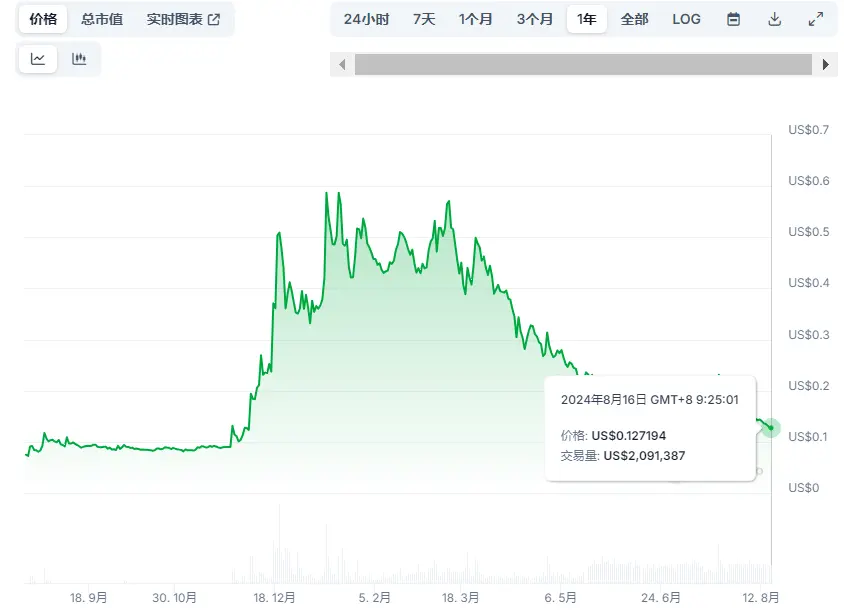
The token DIMO is currently listed on several exchanges including Coinbase and Gate. The token price is $0.12, with a circulation rate of 24%.
Helium Mobile
Helium Mobile is a decentralized hotspot network launched by Helium, where anyone can deploy a hotspot and immediately add dynamic coverage to the Helium mobile network. By expanding coverage and helping build the network, users can earn MOBILE rewards.
According to the Helium website, a licensing program is being launched for its hotspot devices. Helium Mobile's hotspots allow individuals or businesses to establish "mini mobile signal towers," transmit mobile signals, and receive tokens in exchange.
Several third-party manufacturers and suppliers are already providing services for the Helium Internet of Things (IoT) network, but Helium Mobile is currently the only supplier offering devices for mobile signal coverage. Through the licensing program, Helium Mobile aims to earn licensing fees from hotspots manufactured elsewhere while developing its cellular network.
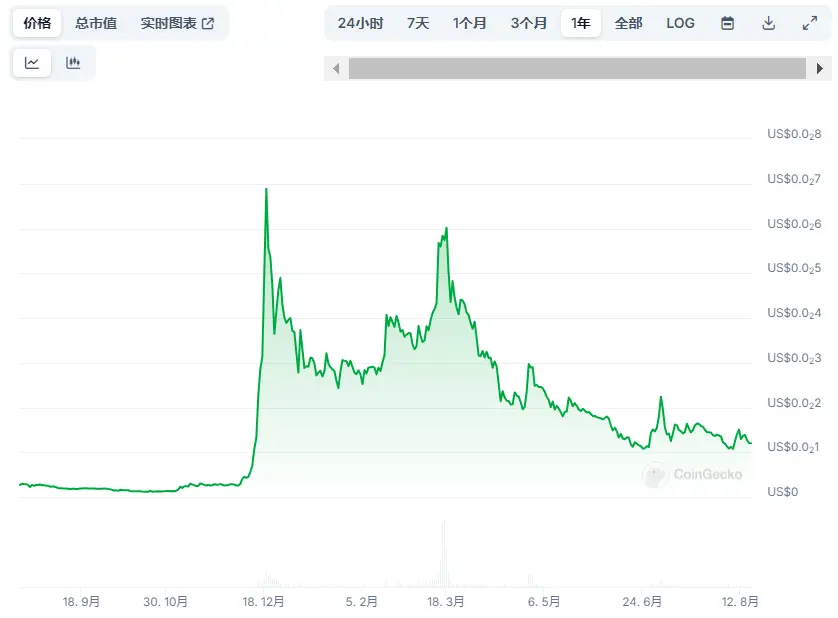
Its token Mobile experienced a crazy surge at the end of last year, rising more than 50 times at its peak. The current price is $0.001, with a circulation rate of 42%.
DAWN
The Solana-based DePIN project Dawn recently raised $18 million, with Dragonfly leading the investment and participation from CMT Digital, Castle Island Ventures, Wintermute Ventures, 6th Man Ventures, and ParaFi. Solana also reprinted the news on X.
Neil Chatterjee, Co-founder of Andrena, stated that this round of financing is an extension of the Series A financing, structured with a Simple Agreement for Future Equity (SAFE) with token warrants. This round of financing was "significantly oversubscribed," with the initial target being only $5 million, but ultimately raising more funds in batches earlier this year to smoothly release tokens.
DAWN utilizes the latest Point-to-Multipoint (PtMP) wireless technology, allowing nodes to efficiently communicate directly with multiple nodes. This allows for high-density bandwidth allocation among many users in the network, turning each node into a mini ISP. Through protocols and hardware, users can buy and sell internet capacity in their local areas, operate as internet providers, and earn income through DAWN nodes.
The current token allocation for DAWN is as follows: various network nodes (i.e., hardware facility participants) will receive 25% of the total token supply as rewards; third-party validators (i.e., software device participants) will receive 7% of the total token supply; the project treasury, team, and investors will hold 20% of the tokens, and the token unlock period is unknown.
The project is still in its early stages, and users can earn early points rewards by downloading a browser plugin to act as a validation node.
Peaq network
Peaq is a Web3 network that supports the Internet of Things (EoT) on Polkadot. Peaq enables entrepreneurs and developers to build decentralized applications for vehicles, robots, and devices, while empowering users to manage and earn income from connected machines providing goods and services.
The DePIN Layer1 protocol Peaq completed a $20 million fundraising event on CoinList on May 17, attracting participation from over 14,500 community members and raising a total of over $36 million, oversubscribing the token issuance of peaq. This event became the largest and highest-donating fundraising event on CoinList in over two years. The new funds will primarily be used to ensure that the peaq-based DePIN becomes an industry leader, accelerate the development of the peaqosystem, and promote various ecosystem and community initiatives.
Additionally, Peaq launched its native token PEAQ on CoinList from May 9 to May 16. However, users from regions such as the United States, Canada, China, and South Korea were unable to participate in this token issuance. Meanwhile, Peaq is actively preparing for the launch of the mainnet to further drive the development of its ecosystem.
Advantages of DePIN
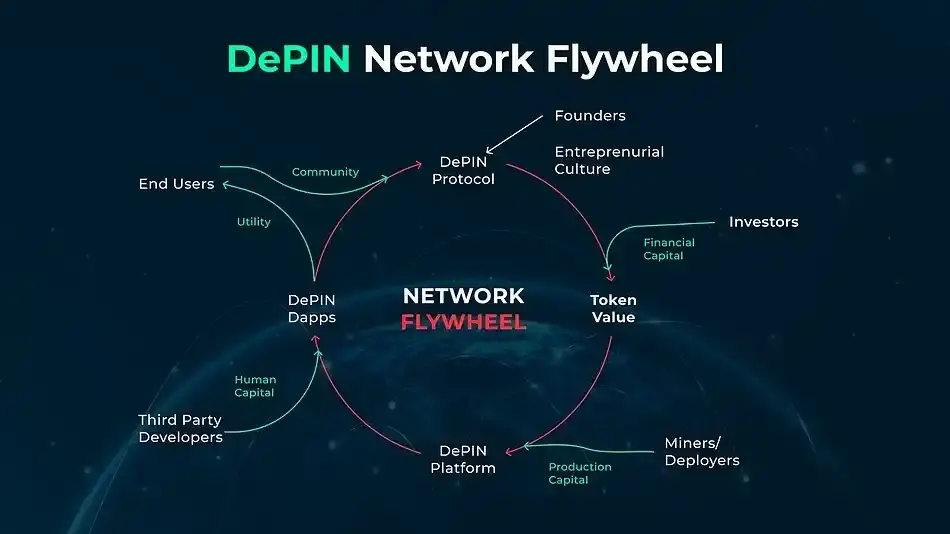
The growth flywheel of the DePIN network, source: Coingecko
Among the eight projects we have reviewed, some have already issued tokens, while others are still in the preparation stage. Compared to traditional centralized infrastructure providers, these DePIN projects demonstrate several clear advantages.
First, DePIN uses cryptographic incentive mechanisms to provide a more efficient capital allocation for capital-intensive and high-maintenance traditional infrastructure. This mechanism not only optimizes the use of funds but also has the potential to reduce costs to a level more acceptable to consumers. Through decentralized means, DePIN can more flexibly mobilize resources, reduce reliance on traditional funding models, and bring more competitive services and products.
Second, the DePIN network creates a highly redundant system by distributing data and services across multiple nodes. This distributed structure ensures that even if a node fails or experiences issues, the rest of the network can continue to operate smoothly. This redundancy design significantly enhances the stability and reliability of the system, reducing the risk of downtime and service interruptions.
Finally, the community-centric approach of DePIN gives local communities the right to manage their networks. This approach not only improves the efficiency of network management but also allows decision-making on resource allocation and maintenance at the grassroots level. This means that infrastructure is not just seen as a tool for economic profit, but as an asset that serves the long-term interests of the community. Community involvement enhances the sense of ownership and responsibility for the infrastructure, while also improving resource utilization efficiency.
Overall, these characteristics highlight the tremendous potential of DePIN in driving infrastructure innovation. Through more efficient capital utilization, enhanced system reliability, and community-driven management, DePIN can not only improve the overall operational efficiency of infrastructure but also have a profound impact on the community, setting new standards for future infrastructure development.
Conclusion
The rapid changes in DePIN remind the author of the transformation in the sharing economy in earlier years, from shared bicycles and shared medical services to shared power banks. The rapid influx of capital does not necessarily mean it is a good thing, especially for DePIN, where capital investment focuses more on the maturity of technology and the expansion of practical application scenarios. Investors hope to see how decentralized technology can be implemented in the real world and bring tangible benefits, which is different from the market expansion model in the early stages of the sharing economy. At the same time, DePIN also faces regulatory risks in the sharing industry, such as data protection, tax compliance, and labor rights, which may affect capital investment.
The green hills cannot hide the flowing water after all.
Despite the challenges and uncertainties, the vigorous development of DePIN under the impetus of decentralized technology is unstoppable and will continue to move forward!
免责声明:本文章仅代表作者个人观点,不代表本平台的立场和观点。本文章仅供信息分享,不构成对任何人的任何投资建议。用户与作者之间的任何争议,与本平台无关。如网页中刊载的文章或图片涉及侵权,请提供相关的权利证明和身份证明发送邮件到support@aicoin.com,本平台相关工作人员将会进行核查。




